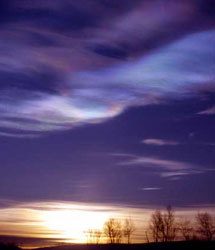 |
 |
 |
 Editorials | Environmental | February 2005 Editorials | Environmental | February 2005  
Arctic Ozone Layer Is Thinning, Scientists Report
 Reuters Reuters

North Europe faces radiation danger if cold conditions continue.


These mother of pearl clouds, seen over Norway, consist of ice particles and are an indicator of a thinning ozone layer. The European Commission has issued a warning about dangerously high UV radiation levels in the north over the next few months. (Photo: JPL) |
The ozone layer over the Arctic has thinned due to colder-than-normal temperatures, and "large scale losses" are likely if the cold conditions continue, a European research group reported.

The research prompted the European Commission on Monday to issue a statement warning that "should further cooling of the Arctic stratosphere occur, increasing ozone losses can be expected for the next couple of decades."

It said the thinning could affect the Polar regions, Scandinavia and possibly as far down as central Europe.

Neil Harris, a researcher with the European Ozone Research Coordinating Unit, said in a statement that "the meteorological conditions we are now witnessing resemble and even surpass the conditions of the 1999-2000 winter - when the worst ozone loss to date was observed."

Overall temperatures in the Arctic ozone layer are the lowest in 50 years, and have been consistently low for the past two months, the group added.

Clouds an Indicator

The concerns were triggered last November, when researchers found large areas of clouds in the ozone layer at an altitude of about 12 miles. Called polar stratospheric clouds, or PSC, they are the largest seen in the last 20 years and are an indicator of ozone depletion.

"Preliminary analysis of data from the international ozonesonde network shows the first signs of depletion at around 20 kilometers altitude," Markus Rex, a researcher with the Alfred Wegener Institute for Polar and Marine Research, said in the statement.

"Overall, measured by the extent and persistence of conditions for PSC formation, the situation is now colder than anything I have seen in the Arctic before," he added. "In particular, the large extent of ice clouds gives reason for concern."

The researchers noted that the clouds cause significant changes in the chemical balance of the stratosphere, which in turn speeds up ozone destruction in the presence of sunlight. The combination alters the breakdown of CFCs, the class of chemicals that erode the ozone layer.

CFCs are being phased out, but their impact will continue for decades. They have also led to thinning of the Antarctic ozone layer.

February, March Will Be Key

The European researchers said that if the Arctic stratosphere remains cold in February and March, large ozone loss is expected to take place as sunlight returns.

That, in turn, could lead to "increased levels of ultraviolet radiation in inhabited areas in the northern part of Europe," they warned.

"It is still too early to predict the temperature development in February and March, which are the crucial months for ozone loss in the Arctic," Harris said, but "we will watch the development closely from day to day, and will inform the public and our authorities if the situation becomes worrying."

The researchers are part of the SCOUT-O3 Integrated Project. Funded by the European Union, it is coordinated at the University of Cambridge's Department of Chemistry. | 
 | |
 |



